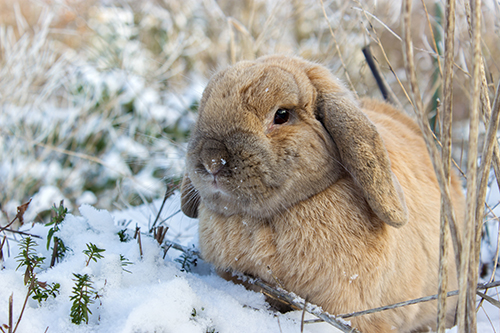How to Keep Your Rabbits Warm During the Winter
Nov 22, 2022

From our friends at Vetsnow
Keeping rabbits warm outside in winter
It is important for rabbit owners to do whatever they can to ensure their pets are safe and warm during cold weather snaps, as domesticated rabbits are not as efficient at keeping themselves warm as their wild counterparts.
In the wild, rabbits live in burrows underground, usually in groups to keep themselves warm. Wild rabbits are also better equipped to deal with lower temperatures due to having thicker fur.
Hutches don’t offer the same level of insulation or protection as burrows because they’re above-ground and are often vulnerable to wind and rain. If a rabbit’s home is exposed to the elements in winter, rabbits can suffer from potentially fatal hypothermia.
Making a rabbit hutch winter proof
Rabbits can usually withstand wintry weather as long as they have a well-insulated, weatherproof hutch.
However, in extreme temperatures, it is worth considering moving the hutch to a shed or garage, provided the garage isn’t in use as toxic car fumes can seriously harm your rabbit’s health. Just make sure they still have access to a safe, covered exercise run.
Four tips to make your rabbit hutch winter ready
It’s important to ensure your rabbit hutch is free from drafts, but at the same time well ventilated.
Placing the hutch in an area sheltered from the elements is the best way to keep your rabbits warm and safe. You should also insulate the hutch with newspaper and hay and remember to change this regularly.
Feeding and watering rabbits in winter
Falling temperatures can lead to your rabbit’s water bottle freezing, preventing them from re-hydrating. Check your rabbit’s water supply regularly to ensure that it is not frozen.
Rabbits tend to eat more food in winter to keep their body temperature at a stable level. Make sure to increase your rabbit’s food and hay in the colder months, so they have enough energy to stay warm.
Rabbit body temperature
Hypothermia is a risk for rabbits in winter. It occurs when the body temperature falls below normal (38.5-40°C). This can be even more dangerous than a fever.
Rabbits suffering from hypothermia will become lethargic, and their extremities, such as their ears and paws, will look pale and feel cool to the touch. In advanced stages, the rabbit will appear as if in a stupor. If untreated, hypothermia can be fatal.
For more content like this, check out the latest issue of The Cooperator.
Keeping rabbits warm outside in winter
It is important for rabbit owners to do whatever they can to ensure their pets are safe and warm during cold weather snaps, as domesticated rabbits are not as efficient at keeping themselves warm as their wild counterparts.
In the wild, rabbits live in burrows underground, usually in groups to keep themselves warm. Wild rabbits are also better equipped to deal with lower temperatures due to having thicker fur.
Hutches don’t offer the same level of insulation or protection as burrows because they’re above-ground and are often vulnerable to wind and rain. If a rabbit’s home is exposed to the elements in winter, rabbits can suffer from potentially fatal hypothermia.
Making a rabbit hutch winter proof
Rabbits can usually withstand wintry weather as long as they have a well-insulated, weatherproof hutch.
However, in extreme temperatures, it is worth considering moving the hutch to a shed or garage, provided the garage isn’t in use as toxic car fumes can seriously harm your rabbit’s health. Just make sure they still have access to a safe, covered exercise run.
Four tips to make your rabbit hutch winter ready
- Check the roof of the hutch is in good condition and 100% waterproof. Any wooden panels or joints inside the hutch should be dry and show no sign of mold or water stains.
- Check that the back and sides of the hutch are in good condition and painted or varnished to protect them from the elements, as these areas can allow rain or moisture to seep through. Inspect for damp patches or rotten wood as well.
- Keeping a rabbit hutch close to the ground not only allows predators easier access to your rabbit’s home, but also puts your pet in danger of water damage or frost. Raise your hutch off the ground on tall legs to prevent the bottom from freezing or being damaged by water, as well as to make it more difficult for predators to get into the hutch.
It’s important to ensure your rabbit hutch is free from drafts, but at the same time well ventilated.
Placing the hutch in an area sheltered from the elements is the best way to keep your rabbits warm and safe. You should also insulate the hutch with newspaper and hay and remember to change this regularly.
Feeding and watering rabbits in winter
Falling temperatures can lead to your rabbit’s water bottle freezing, preventing them from re-hydrating. Check your rabbit’s water supply regularly to ensure that it is not frozen.
Rabbits tend to eat more food in winter to keep their body temperature at a stable level. Make sure to increase your rabbit’s food and hay in the colder months, so they have enough energy to stay warm.
Rabbit body temperature
Hypothermia is a risk for rabbits in winter. It occurs when the body temperature falls below normal (38.5-40°C). This can be even more dangerous than a fever.
Rabbits suffering from hypothermia will become lethargic, and their extremities, such as their ears and paws, will look pale and feel cool to the touch. In advanced stages, the rabbit will appear as if in a stupor. If untreated, hypothermia can be fatal.
For more content like this, check out the latest issue of The Cooperator.